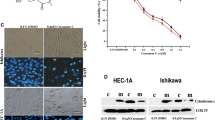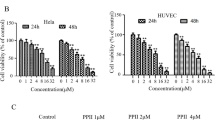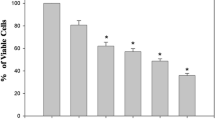Abstract
Recently, diterpenoids have been shown to exhibit several health benefits including cancer prevention. In the present study, we examined the anticancer effects of sugiol diterpene against the endometrial carcinoma and attempted to explore the underlying mechanisms. The results showed that sugiol significantly (P < 0.05) inhibited the proliferation of the endometrial carcinoma cell lines (HEC-1-A, HEC-1-B, and KLE) as compared to the normal THESCs cells. The IC50 of sugiol against all the three endometrial carcinoma cell lines ranged between 14 and 18 µM as against an IC50 of 110 μM against the normal THESCs cells. Sugiol caused several changes in the morphology of the HEC-1-B cells characteristic of apoptosis. The DAPI and annexin PI assays confirmed the induction of apoptosis in HEC-1-B cells. Sugiol also triggered increase in Bax and decrease in Bcl-2 expression. The acridine orange staining revealed that the formation of autolysosomes in HEC-1-B cells upon treatment with sugiol suggestive of autophagy. The autophagy was further confirmed by increase in the expression of LC3B-II, Beclin-1, Atg5, and Atg12 and decrease in the expression of P62. The transwell assay showed that relative to the untreated HEC-1-B cells, the migration and invasion of the sugiol-treated HEC-1-B cells was significantly (P < 0.05) inhibited. Collectively, the finding of the present study revealed that sugiol suppresses the growth of human endometrial cells via induction of apoptosis and autophagy. Consistently, sugiol may prove to be an important lead molecule in the development of chemotherapy for endometrial carcinoma.




Similar content being viewed by others
References
Bajpai VK, Sharma A, Kang SC, Baek KH (2014a) Antioxidant, lipid peroxidation inhibition and free radical scavenging efficacy of a diterpenoid compound sugiol isolated from Metasequoia glyptostroboides. Asian Pac J Trop Med 7:9–15
Bajpai VK, Sharma A, Kang SC, Baek KH (2014b) Antioxidant, lipid peroxidation inhibition and free radical scavenging efficacy of a diterpenoid compound sugiol isolated from Metasequoia glyptostroboides. Asian Pac J Trop Med 7(1):9–15
Burlacu A (2003) Regulation of apoptosis by Bcl-2 family proteins. J Cell Mol Med 7:249–257
Chao KP, Hua KF, Hsu HY, Su YC, Chang ST (2005) Anti-inflammatory activity of sugiol, a diterpene isolated from Calocedrus formosana bark. Planta Med 71(04):300–305
Coll-de la Rubia E, Martinez-Garcia E, Dittmar G, Gil-Moreno A, Cabrera S, Colas E (2020) Prognostic biomarkers in endometrial cancer: a systematic review and meta-analysis. J Clin Med 9:1900
Córdova I, León LG, León F, San Andrés L, Luis JG, Padrón JM (2006) Synthesis and antiproliferative activity of novel sugiol β-amino alcohol analogs. Eur J Med Chem 41:1327–1332
Gibson WJ, Hoivik EA, Halle MK et al (2016) The genomic landscape and evolution of endometrial carcinoma progression and abdominopelvic metastasis. Nat Genet 48:848
Glick D, Barth S, Macleod KF (2010) Autophagy: cellular and molecular mechanisms. J Pathol 221:3–12
Hao C, Zhang X, Zhang H, Shang H, Bao J, Wang H, Li Z (2018) Sugiol (12-hydroxyabieta-8, 11, 13-trien-7-one) targets hu-man pancreatic carcinoma cells (Mia-PaCa2) by inducing apoptosis, G2/M cell cycle arrest, ROS production and inhibition of cancer cell migration. J BUON 23(1):205–210
Jung SN, Shin DS, Kim HN et al (2015) Sugiol inhibits STAT3 activity via regulation of transketolase and ROS-mediated ERK activation in DU145 prostate carcinoma cells. Biochem Pharmacol 97:38–50
Knekt P, Kumpulainen J, Jarvinen R et al (2002) Flavonoid intake and risk of chronic diseases. Am J Clin Nutr 76:560–568
Kuo YH, Yu MT (1996) Dehydroabietane diterpenes from Juniperus formosana Hay. var. concolor Hay. Phytochemistry 42(3):779–781
Leslie KK, Thiel KW, Goodheart MJ, De Geest K, Jia Y, Yang S (2012) Endometrial cancer. Obstet Gynecol Clin North Am 39:255–268
Li Q, Zhang J, Liang Y, Mu W, Hou X, Ma X, Cao Q (2018) Tanshinone l exhibits anticancer effects in human endometrial carcinoma HEC-1-A cells via mitochondrial mediated apoptosis, cell cycle arrest and inhibition of JAK/STAT signalling pathway. J BUON 23:1092–1096
Newman DJ, Cragg GM (2012) Natural products as sources of new drugs over the 30 years from 1981 to 2010. J Nat Prod 75:311–335
Núñez MJ, Reyes CP, Jiménez IA, Hayashi H, Tokuda H, Bazzocchi IL (2010) ent-Rosane and abietane diterpenoids as cancer chemopreventive agents. Phytochemistry 72(4–5):385–390
Piulats JM, Guerra E, Gil-Martín M, Roman-Canal B, Gatius S, Sanz-Pamplona R, Velasco A, Vidal A, Matias-Guiu X (2017) Molecular approaches for classifying endometrial carcinoma. Gynecol Oncol 145:200–207
Redza-Dutordoir M, Averill-Bates DA (2016) Activation of apoptosis signalling pathways by reactive oxygen species. Biochim Biophys Acta Mol Cell Res 1863:2977–2992
Scariot DB, Volpato H, Fernandes ND et al (2019) Activity and cell-death pathway in leishmania infantum induced by sugiol: Vectorization using yeast cell wall particles obtained from Saccharomyces cerevisiae. Front Cell Infect Microbiol 9:208
Shin DS, Shin KD, Yoon YJ, Kim JH, Han DC, Son KH, Kwon BM (2007) Cancer biology; sugiol isolated from the cones of Sequoia sempervirens inhibits growth of DU145 Prostate cancer cells via inactivation of JAK2/STAT3 pathway. 생화학분자생물학회 춘계학술발표논문집 2007:321–321.
Souren PA, Jakhar R, Bhardwaj M, Kang SC (2013) Autophagy inhibition promotes sugiol induced apoptosis in colon carcinoma cell. 한국생물공학회 학술대회. 10:295–295.
Takano S, Gately S, Neville ME, Herblin WF, Gross JL, Engelhard H, Perricone M, Eidsvoog K, Brem S (1994) Suramin, an anticancer and angiosuppressive agent, inhibits endothelial cell binding of basic fibroblast growth factor, migration, proliferation, and induction of urokinase-type plasminogen activator. Cancer Res 54:2654–2660
Travaglino A, Raffone A, Mascolo M, Guida M, Insabato L, Zannoni GF, Zullo F (2020) Clear cell endometrial carcinoma and the TCGA classification. Histopathology 76:336–338
Ulubelen A, Öksüz S, Kolak U, Bozok-Johansson C, Çelik C, Voelter W (2000) Antibacterial diterpenes from the roots of Salvia viridis. Planta Med 66:458–462
Wang Y, Shi LY, Qi WH, Yang J, Qi Y (2020) Anticancer activity of sugiol against ovarian cancer cell line SKOV3 involves mitochondrial apoptosis, cell cycle arrest and blocking of the RAF/MEK/ERK signalling pathway. Arch Med Sci 16:428–435
Xu G, Kan WL, Zhou Y et al (2010) Cytotoxic acylphloroglucinol derivatives from the twigs of Garcinia cowa. J Nat Prod 73:104–108
Acknowledgements
The authors acknowledge Central hospital of Chengde, Chengde, Hebei, China, 067000 for providing laboratory and instrumentation facalities.
Funding
This research did not obtain any specific Grant from funding agencies in the public, commercial, or not-for-profit sectors.
Author information
Authors and Affiliations
Contributions
Conceptualization: HZ and XZ; methodology: HZ and XZ; formal analysis and investigation: HZ and XZ; writing—original draft preparation: HZ and XZ; writing—review and editing critically for important intellectual content: HZ and XZ; supervision: XZ.
Corresponding author
Ethics declarations
Conflict of interest
All the authors declare that they have no conflict of interest.
Ethical approval
This article does not contain any studies with human participants or animals performed by any of the authors.
Rights and permissions
About this article
Cite this article
Zhao, H., Zhang, X. Sugiol suppresses the growth, migration, and invasion of human endometrial cancer cells via induction of apoptosis and autophagy. 3 Biotech 11, 234 (2021). https://doi.org/10.1007/s13205-020-02625-3
Received:
Accepted:
Published:
DOI: https://doi.org/10.1007/s13205-020-02625-3




